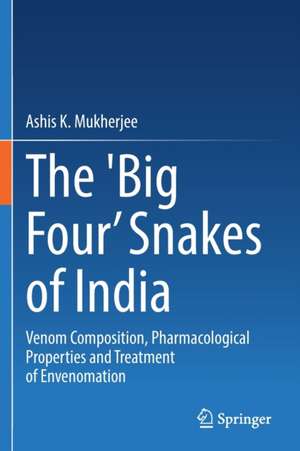The 'Big Four’ Snakes of India: Venom Composition, Pharmacological Properties and Treatment of Envenomation
Autor Ashis K. Mukherjeeen Limba Engleză Paperback – 28 aug 2022
This book caters to toxinologists, pharmacologists, zoologists, antivenom manufacturers, biochemists, clinicians, evolutionary biologists, herpetologists, and informed non-specialists interested to know about the Indian snake venoms.
| Toate formatele și edițiile | Preț | Express |
|---|---|---|
| Paperback (1) | 899.41 lei 43-57 zile | |
| Springer Nature Singapore – 28 aug 2022 | 899.41 lei 43-57 zile | |
| Hardback (1) | 905.73 lei 43-57 zile | |
| Springer Nature Singapore – 27 aug 2021 | 905.73 lei 43-57 zile |
Preț: 899.41 lei
Preț vechi: 946.74 lei
-5% Nou
Puncte Express: 1349
Preț estimativ în valută:
172.10€ • 180.14$ • 143.24£
172.10€ • 180.14$ • 143.24£
Carte tipărită la comandă
Livrare economică 31 martie-14 aprilie
Preluare comenzi: 021 569.72.76
Specificații
ISBN-13: 9789811628986
ISBN-10: 981162898X
Ilustrații: XI, 161 p. 55 illus.
Dimensiuni: 155 x 235 mm
Greutate: 0.28 kg
Ediția:1st ed. 2021
Editura: Springer Nature Singapore
Colecția Springer
Locul publicării:Singapore, Singapore
ISBN-10: 981162898X
Ilustrații: XI, 161 p. 55 illus.
Dimensiuni: 155 x 235 mm
Greutate: 0.28 kg
Ediția:1st ed. 2021
Editura: Springer Nature Singapore
Colecția Springer
Locul publicării:Singapore, Singapore
Cuprins
Chapter 1. Introduction: The snakebite problem.- Chapter 2. Evolution of snakes and systematics of Big Four venomous snakes of India.- Chapter 3. Snake venom: Composition, evolution, function, and biomedical applications.- Chapter 4. Indian spectacled cobra (Naja naja).- Chapter 5. Indian common Krait (Bungarus cerelus).- Chapter 6. Indian Russell’s viper (Daboia russelii).- Chapter 7. Indian Saw-scaled viper (Echis carinatus).- Chapter 8. Prevention and Treatment of Big Four Snakebite in India.
Notă biografică
Prof. Ashis K. Mukherjee is the Director of the Institute of Advanced Study in Science and Technology, Guwahati, Assam, India, and a Professor of Molecular Biology and Biotechnology Tezpur University, Assam, India. He did M. Sc. (Biochemistry) from Banaras Hindu University, Ph. D. in biochemistry and pharmacology of Indian Cobra and Russell’s viper venom from Burdwan Medical College under Burdwan University, and D. Sc. (Biotechnology) from Calcutta University on characterization and biotechnological application of phospholipase A2 and proteases from Indian Cobra and Russell’s viper venom. Prof. Mukherjee has more than 25 years of research experience on Indian snake venoms and the treatment of venomous snakebites. His current research interest includes biochemical, pharmacological, and proteomic analyses of Indian snake venoms, quality assessment of commercial antivenom, and novel diagnostics and drug discovery from natural resources, including snake venom. He has published numerous research papers in peer-reviewed national and international journals and book chapters, guided Ph. D. students, and received several awards and medals for his academic competence and research achievements, the most notable is the Visitor’s Award for Research in Basic and Applied Sciences from honorable President of India in 2018. Prof. Mukherjee is also the task force member of the Department of Biotechnology, Ministry of Science and Technology, Government of India, Indian Council of Medical Research, Government of India, and World Health Organization (WHO) on prevention and control of snakebite envenoming.
Textul de pe ultima copertă
This book provides detailed and updated knowledge about medically important ‘Big Four’ venomous snakes of India (Indian spectacled cobra, Indian common krait, Indian Russell’s viper, and Indian saw-scaled viper). This book essentially covers the snakebite problem in the world with particular reference to Asia and India. It discusses the evolution and systematics of venomous snakes, emphasizing ‘Big Four’ venomous snakes of India; the evolution and composition of venoms determined by traditional biochemical and modern proteomic analyses. It also describes the pharmacological properties of enzymatic and non-enzymatic toxins of ‘Big Four’ venomous snakes of India. Different chapters discuss exciting topics such as species-specific and geographical differences in venom composition and its impact on pathophysiology and clinical manifestations of snakebite envenomation in India, biomedical application of Indian snake venom toxins; production and quality assessment of commercial antivenom,prevention, and treatment of snakebite in India, adverse effects of antivenom including strategies to combat antivenom reactions inpatient.
This book caters to toxinologists, pharmacologists, zoologists, antivenom manufacturers, biochemists, clinicians, evolutionary biologists, herpetologists, and informed non-specialists interested to know about the Indian snake venoms.
This book caters to toxinologists, pharmacologists, zoologists, antivenom manufacturers, biochemists, clinicians, evolutionary biologists, herpetologists, and informed non-specialists interested to know about the Indian snake venoms.
Caracteristici
Describes Biochemical composition, pharmacological properties of Big Four snake venoms and their pathophysiological and clinical manifestations in snakebite patients Describes proteomic approach to decipher the venom proteome composition of Big Four venomous snakes of India Provide details about production of commercial anti-snake venom, treatment of snakebite, and limitations of antivenom therapy Enlists candidate drug prototypes from Indian snake venom some of which have market demand for the treatment of various diseases such as cancer, cardiovascular diseases, and wound healing
